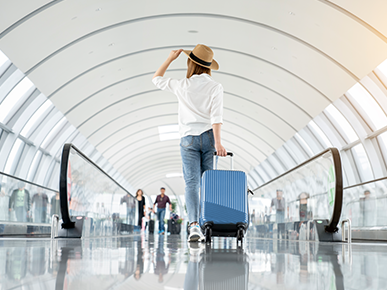Pregnancy travel insurance
Are you planning a well-deserved holiday before your little miracle arrives? First things first, congratulations!
Now down to business, because travelling while pregnant requires a bit more planning and preparation than your average trip, and comprehensive travel insurance is important.
What we cover
We know that this time of your life can be equally stressful as it is special. That’s why we provide great quality, affordable insurance for pregnant travellers - so you can have the peace of mind knowing that you and your baby are protected.
Our International Comprehensive and International Medical Only policies cover you for costs or losses relating to your pregnancy up to and including the 24th week (the first 23 weeks and 6 days), so long as your pregnancy was without complication before your start date of insurance.
We cover single and multiple pregnancies (for example twins or triplets), as well as those that were conceived through fertility treatment.
There is also cover under our international policies for neonatal care of your newborn. We recommend that, when comparing pregnancy travel insurance options with other providers, you make sure you check whether neonatal care is included in your cover.
Travel insurance in the first 24 weeks
A quick holiday earlier in your pregnancy can be a great way to relax and unwind, but there are certain things to remember.
When planning your babymoon, think seriously about your comfort and ensure your destination and accommodation won’t place you under unnecessary stress. Flying while pregnant can be uncomfortable, so opt for countries that are a short distance from Australia.
Always discuss your travel plans with your doctor and seek their professional advice before booking your trip.
What we can’t cover
There are a few things we don’t cover, like claims, costs or losses directly or indirectly arising from or related to or associated with:
- common pregnancy symptoms including breast tenderness, constipation, fatigue, frequent urination, heartburn and nausea (morning sickness); or
- any pre-existing medical condition(s) relating to pregnancy (for example pre-eclampsia, recurrent miscarriage (i.e. three or more miscarriages), small for date baby and postnatal depression) that are not covered condition(s).
We won't cover any pregnancy after the 24th week of gestation.
What happens if I give birth whilst on holiday?
Given that airlines restrict expectant mothers from flying when late into their pregnancies, it’s unlikely that you’ll give birth while on holiday, however, if this scenario does arise, seek emergency medical care.
We will cover the following medical expenses related to pregnancy:
- childbirth up until the 24th week (the first 23 weeks and 6 days)
- neo-natal care of the new-born child up until the date and time you return to Australia.
We won't cover any pregnancy after the 24th week of gestation.
Travel tips for pregnant mothers
Expectant mothers have a lot to think about when organising a babymoon. But above all, they should think about the health of themselves and their child. Remember to:
- Choose a relaxing destination - Think coastal relaxation over caving in Peru. Your babymoon should be your chance to unwind, get in tune with your body and look forward to the great years to come.
- Opt for shorter flights - Long-haul missions to Los Angeles or London are physically and mentally challenging at the best of times, let alone when pregnant. Do your body a favour and choose a destination close to Australia.
- Pay for the legroom - Comfort is key. If possible, fork out for premium economy/business class seats for a bit of extra legroom, and remember to wear loosely fitting clothes when flying.
- Ask your doctor - Always seek advice from your doctor, including asking about vaccination recommendations, as some vaccinations aren’t suitable for pregnant mothers.
- Be kind to your stomach - Tackle morning sickness by staying active, avoiding rich and spicy foods, and using anti-nausea medication (if your doctor has advised it is safe to do so).
Packing list for travelling while pregnant
Whether it’s a quick weekend away or a longer tropical escape, all pregnant mothers should prepare carefully when packing their carry-on bags. Remember the essentials to keep you comfortable:
- Pregnancy vitamins
- Compression socks to prevent DVT
- Ginger sweets for nausea
- Antacids for heartburn
- A comfy pillow
- A reusable water bottle – just ask the attendant to fill it up
- Loose, comfortable clothing
What you need to know
This page includes some information about our products but, as with all insurance policies, eligibility criteria, terms and conditions apply. For our terms and conditions (including information about exclusions, excesses and sub limits) we recommend you read the relevant Financial Services Guide (FSG), Product Disclosure Statement (PDS) and Target Market Determination (TMD) to ensure our travel insurance products are right for you.
You can find the relevant documents here: International Comprehensive, Annual Multi-trip, International Medical Only, Working Overseas, Domestic.






